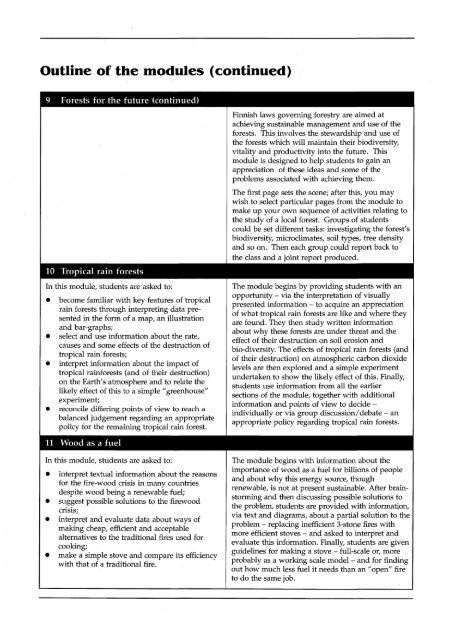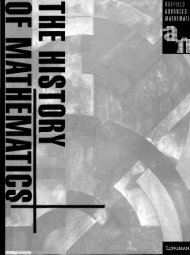UNESCO resource kit - science and technology educa...
UNESCO resource kit - science and technology educa...
UNESCO resource kit - science and technology educa...
Create successful ePaper yourself
Turn your PDF publications into a flip-book with our unique Google optimized e-Paper software.
Outline of the modules (continued)<br />
9 Forests for the future (continued)<br />
10 Tropical rain forests<br />
In this module, students are asked to:<br />
• become familiar with key features of tropical<br />
rain forests through interpreting data presented<br />
in the form of a map, an illustration<br />
<strong>and</strong> bar-graphs;<br />
• select <strong>and</strong> use information about the rate,<br />
causes <strong>and</strong> some effects of the destruction of<br />
tropical rain forests;<br />
• interpret information about the impact of<br />
tropical rainforests (<strong>and</strong> of their destruction)<br />
on the Earth's atmosphere <strong>and</strong> to relate the<br />
likely effect of this to a simple" greenhouse"<br />
experiment;<br />
• reconcile differing points of view to reach a<br />
balanced judgement regarding an appropriate<br />
policy for the remaining tropical rain forest.<br />
11 Wood as a fuel<br />
In this module, students are asked to:<br />
• interpret textual information about the reasons<br />
for the fire-wood crisis in many countries<br />
despite wood being a renewable fuel;<br />
• suggest possible solutions to the firewood<br />
crisis;<br />
• interpret <strong>and</strong> evaluate data about ways of<br />
making cheap, efficient <strong>and</strong> acceptable<br />
alternatives to the traditional fires used for<br />
cooking;<br />
• make a simple stove <strong>and</strong> compare its efficiency<br />
with that of a traditional fire.<br />
Finnish laws governing forestry are aimed at<br />
achieving sustainable management <strong>and</strong> use of the<br />
forests. Thisinvolves the stewardship <strong>and</strong> use of<br />
the forests which will maintain their biodiversity,<br />
vitality <strong>and</strong> productivity into the future. ~his<br />
module is designed to help students to gam an<br />
appreciation of these ideas <strong>and</strong> some of the<br />
problems associated with achieving them.<br />
The first page sets the scene; after this, you may<br />
wish to select particular pages from the module to<br />
make up your own sequence of activities relating to<br />
the study of a local forest. Groups of students<br />
could be set different tasks: investigating the forest's<br />
biodiversity, microclimates, soil types, tree density<br />
<strong>and</strong> so on. Then each group could report back to<br />
the class <strong>and</strong> a joint report produced.<br />
The module begins by providing students with an<br />
opportunity - via the interpretation of visual~y .<br />
presented information - to acquire an appreciation<br />
of what tropical rain forests are like <strong>and</strong> where they<br />
are found. They then study written information<br />
about why these forests are under threat <strong>and</strong> the<br />
effect of their destruction on soil erosion <strong>and</strong><br />
bio-diversity. The effects of tropical rain fores~s (~nd<br />
of their destruction) on atmospheric carbon dioxide<br />
levels are then explored <strong>and</strong> a simple experiment<br />
undertaken to show the likely effect of this. Finally,<br />
students use information from all the earlier<br />
sections of the module, together with additional<br />
information <strong>and</strong> points of view to decide -<br />
individually or via group discussion/debate - an<br />
appropriate policy regarding tropical rain forests.<br />
The module begins with information about the<br />
importance of wood as a fuel for billions of people<br />
<strong>and</strong> about why this energy source, though<br />
renewable, is not at present sustainable. After brainstorming<br />
<strong>and</strong> then discussing possible solutions to<br />
the problem, students are provided with information,<br />
via text <strong>and</strong> diagrams, about a partial solution to the<br />
problem - replacing inefficient 3-stone fires with<br />
more efficient stoves - <strong>and</strong> asked to interpret <strong>and</strong><br />
evaluate this information. Finally, students are given<br />
guidelines for making a stove - full-scale or, n:or:<br />
probably as a working scale model - <strong>and</strong> for finding<br />
out how much less fuel it needs than an "open" fire<br />
to do the same job.

















